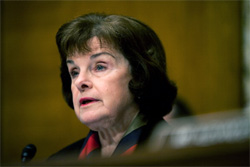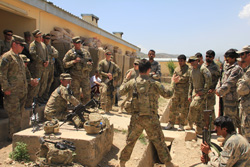A destination on the Interweb to brighten your day (now get back to work!)
Wednesday, May 4, 2011
Ex-Justice Department Official: Obama Could Be Forced to Release the Osama Death Photos

| By John Cook Ex-Justice Department Official: Obama Could Be Forced to Release the Osama Death Photos
Up until a few moments ago, when CBS News reported Obama's decision, the Administration had issued mixed signals on whether it intended to release graphic evidence of Osama's demise. CIA director Leon Panetta stated that he expected a photo would eventually be released, while Defense Secretary Robert Gates and Secretary of State Hilary Clinton were reportedly opposed. White House Press Secretary Jay Carney said yesterday that "there are sensitivities here in terms of the appropriateness of releasing photographs of Osama bin Laden in the aftermath of this firefight." But all the agonizing may have been for naught. According to Daniel Metcalfe, the former chief of the Department of Justice's Office of Information and Privacy—a post that effectively made him the government's top expert in the Freedom of Information Act—the odds are better than even that a FOIA lawsuit seeking the photo's release would succeed. "If someone brought a FOIA complaint seeking the photo, and the government had improperly classified it, I think the government would lose," Metcalfe, who supervised the defense of more than 500 FOIA and Privacy Act lawsuits for the U.S., told Gawker. He is now the executive director of the Collaboration on Government Secrecy at American University's Washington College of Law.
"As far as photos of the corpse go," said Kel McClanahan, the executive director of National Security Counselors, a law firm specializing in litigating secrecy issues, "there's nothing I can reasonably think of that would exempt that, unless someone classified them." The government could conceivably try to deny a FOIA request for the photos based on the statute's privacy exemptions, but that would put it in the awkward position of going to court to protect Osama bin Laden's surviving family members' privacy. So classification is the best bet. Trouble is, you can't simply classify things because you don't want them released. There has to be a reason. And according to Metcalfe, it's hard to imagine a good reason to classify a simple photograph of bin Laden's corpse. "I don't know of the basis upon which such a photo could properly be classified," Metcalfe says. "It might be classified in a gross sense—as in, 'this entire series of images in a DOD or CIA digital camera, taken during a highly classified operation, is classified.' But I can't imagine on what basis a single image of Osama bin Laden could be classified on its own." According to the executive order governing classification, information can be classified if its "disclosure could reasonably be expected to cause identifiable or describable damage to the national security" and it pertains to a list of sensitive subjects including military plans, foreign governments, or nuclear weapons. If Obama decides thinks release of the photos could inflame the Middle East, he could claim that national security is at risk. And the executive order does allow for the classification of "intelligence activities (including covert action)," which would seem to cover such a highly secretive mission. Trouble is, federal law defines covert action as "an activity or activities of the United States Government to influence political, economic, or military conditions abroad, where it is intended that the role of the United States Government will not be apparent or acknowledged publicly" [pdf]. The role of the United States in killing Osama bin Laden is apparent and has been acknowledged publicly, and was clearly always intended to be acknowledged. It wasn't a covert action. The FOIA only allows properly classified records to be withheld. "If it is classified, and it was classified improperly, then it is highly challengeable in court," Metcalfe says. "It's a tough row to hoe for a FOIA litigant to overcome a classification decision, but there have been cases where courts second-guessed them. It happened just last month in a D.C. District Court case involving the Office of U.S. Trade Representative. I think the odds are very high that the classification action would be rejected, despite the tremendous deference courts give on such matters." McClanahan is less sanguine, arguing that courts would likely give Obama the benefit of the doubt in a FOIA case over the images: "Classified is classified. I can only think of a handful of cases where something is determined to be improperly classified." The last time Obama faced a decision about whether to release potentially explosive images, it was the FOIA that forced his hand. In 2009, the Defense Department was trying to keep dozens of photographs and four videos showing detainee abuse at Abu Ghraib from being released to the ACLU under a FOIA complaint. The government argued that the photos could be withheld under an exemption for law enforcement records that could cause harm to a person if released—the harm in this case being potential riots in the middle east or anticipated retaliation against U.S. soldiers. But the Second Circuit Court of Appeals rejected that argument and ordered the Defense Department to hand them over. Before the Supreme Court could address the issue, Congress passed a special law barring their disclosure. But that law was tailored specifically to the Abu Ghraib photos, and so wouldn't cover Osama. And since there was no law enforcement element to the raid, the government's failed argument in that case couldn't be raised here to see if the Supreme Court will accept it.
Indeed, Carney seemed to hint at that strategy at yesterday's White House press briefing. Asked if he had seen the photos, he declined to answer, adding unbidden that he wouldn't discuss their location either: "I'm not going to get into who's seen the photographs, or where they are." The trouble with that route is that digital images are sticky. If the photos were delivered digitally from Pakistan or Afghanistan to Langley, Va. and Washington, D.C., there could be any number of government servers or devices that retained copies. It would take a coordinated—and possibly illegal—effort to destroy every digital trace of such images at the Department of Defense and CIA. If any such traces remain, they're FOIAble. And it's not just death photos at stake. The White House has also confirmed that video of bin Laden's funeral exists, and there is presumably a wealth of photos of his compound and the aftermath of the raid that could potentially be releasable. Requesters could even try to get a hold of a copy of the real-time video stream that the White House was reportedly watching as the raid went down—though McClanahan said military video is more easily classified. "Video of action like that is usually classified, because someone can take apart strategies and tactics." Of course, if someone does file a complaint under the FOIA seeking access to the images, and it starts to look like a court might force his hand, Obama could turn to Congress for another one-off law protecting the bin Laden photos. But it's unclear if the sentiment in favor keeping the Osama photos will be as unanimous as it was in the Abu Ghraib case. [Photos via The White House/Flickr] | May 4th, 2011 Top Stories |
Today in Slate: The Things That Could Have Gone Wrong in the Raid; Plus, Match Notorious Fugitives To Their Secret Lairs
Manage your newsletters on Slate Unsubscribe | Forward to a Friend | Advertising Information
Please do not reply to this message since this is an unmonitored e-mail address.
Ideas on how to make something better? Send an e-mail to slatenewsletter@nl.slate.com.
Copyright 2011 The Slate Group | Privacy Policy
The Slate Group | c/o E-mail Customer Care | 1350 Connecticut Avenue NW Suite 410 | Washington, D.C. 20036
The Afternoon Scoop - Did CIA Ignore bin Laden Warning?
To receive the text-only version of The Afternoon Scoop click here. Please add thedailybeast@e.thedailybeast.com to your address book.
 |
|
|
|
|

























